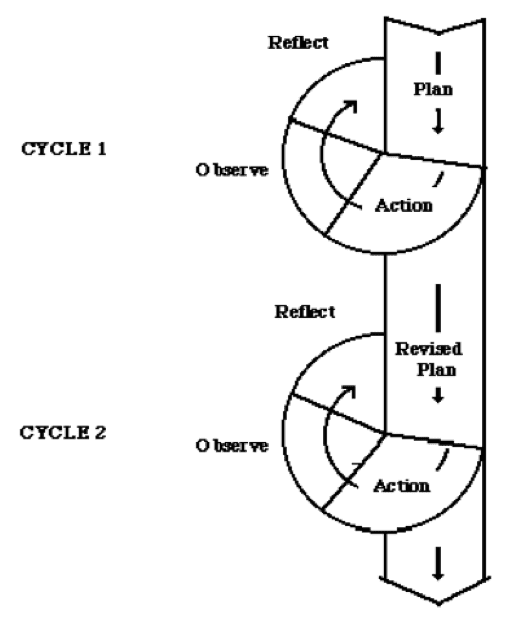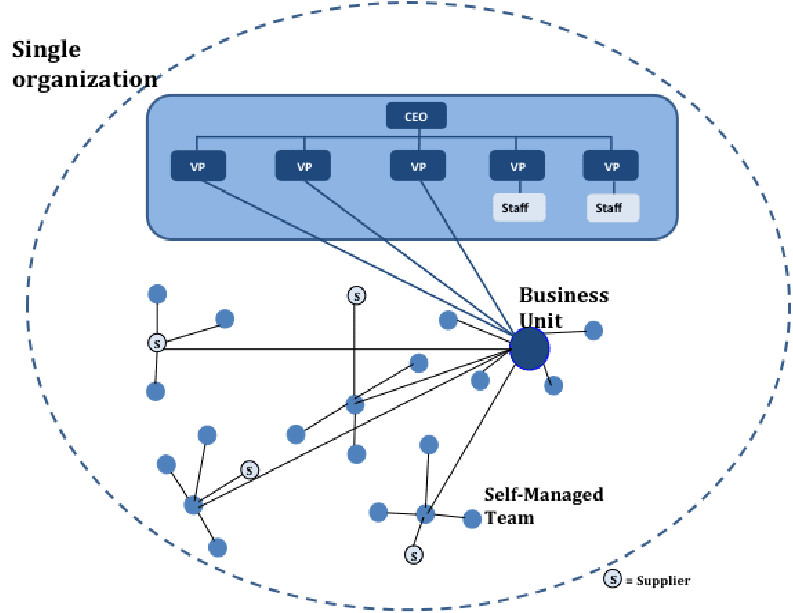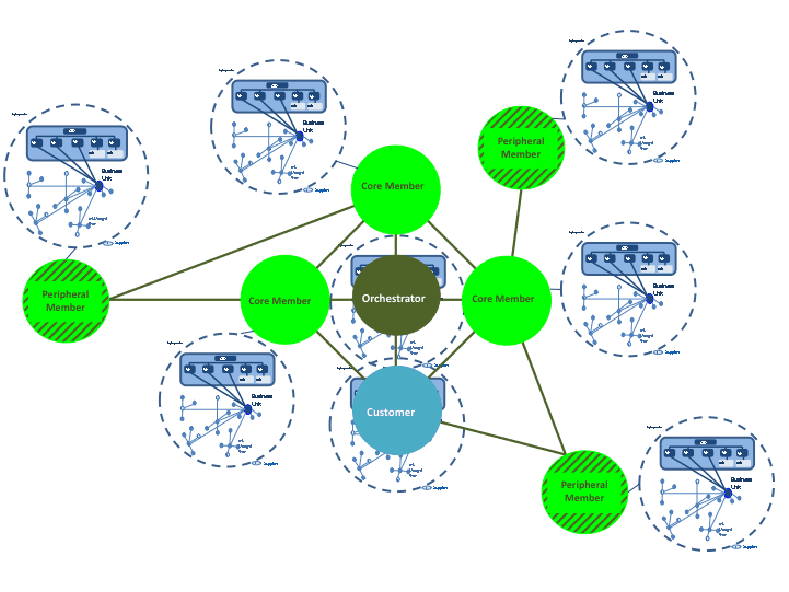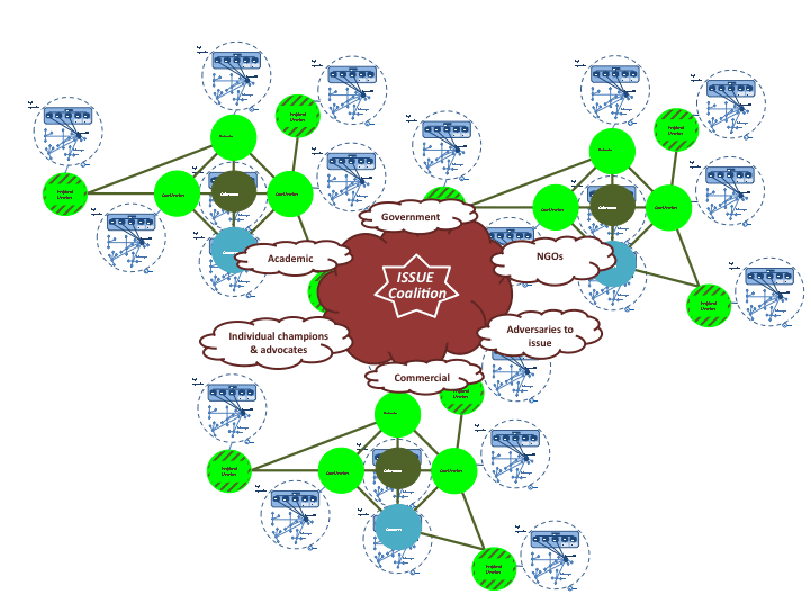STS-RT Discovery Process
Action research has been the foundation of Socio-technical Systems theory and practice since the 1950s work of Trist and Emery in the British coal mines. As a co-learning or “learning-by-doing” process, those involved act to
“. . . contribute both to the practical concerns of people in an immediate
problematic situation and to further the goals of social science
simultaneously. . . . [This] dual commitment . . . to study a system and
concurrently to collaborate with members of the system in changing it . . .
requires the active collaboration of researcher and client, and thus it
stresses the importance of co-learning as a primary aspect of the research
process.”*
The figure below illustrates a simple action research process through which STS practitioners engage with their clients in attempting organizational transformation. Although only two cycles are depicted here, it follows that this process is a series of continuous learning loops whereby the learning is never complete.

Following in the footsteps of our founders, the Socio-technical System’s Roundtable (a learning community of STS practitioners, academics and unionists) initiated its own collective action research in the form of a Discovery Process. As in all attempts at transformation, the journey begins within, and as a community we began our exploration and experimentation as early as 2005. The journey of discovery led us to realize the following—
I. Assumptions and beliefs of STS Designers:
1. All organizations are:
a) open systems and as such need to continuously renew and adapt to opportunities and demands in the environment.
b) socio-technical systems, which function more humanely and effectively when these systems are jointly optimized.
2. STS value proposition:
We create and enable highly participative processes focused on:
a) building a strategy that both responds to and influences the environment.
b) designing work organizations that jointly optimize their social and technical systems to deliver on the aligned strategy.
c) designing, with intent, a high quality of working life for all members . . . which together accelerate the movement toward workplaces and lifespaces that work well and are good to work and live in.
II. Key discoveries:
1. The need for continuous and rapid adaptation (i.e., flexibility of work systems) has increased exponentially.
2. “Member” alienation (isolation, lack of engagement) continues to be a key issue compounded by a new context of significantly greater complexity and pace of change.
3. Issues of coordination within and among the parts of an enterprise are compounded by greater complexity and pace of change.
4. The intentional use of socio-technical networks is becoming more prevalent as a means to achieve cost efficiencies, requisite flexibility and mutual adaptation.
5. New design processes and technologies for meaningful participation are required in both the design and ongoing governance of the organization (i.e., Design Thinking, Appreciative Inquiry, etc.)
6. Three observable new forms of organization or Adaptive Enterprises are evolving at the local, regional, national and global levels in response to the need for flexibility.
Such ‘self-discovery’ during a transformation process is vital before one can move beyond the boundaries of the personal (actions, mindset and identity) and into the realm of the universal. As such, several iterations of ‘thought models’ evolved from a process of rapid prototyping into what we can now share with others. Our hope for today and the future is to extend our boundaries and learning to collectively articulate that which is universal relative to design methods, principles and processes for organizing in the 21st century.
Today, we are expanding our learning community and creating yet another iteration of models and tools. It is our intention to repeat this face-to-face process again in Atlanta (April 2012), Boston (August 2012) and in Canterbury, England (September 2012). In the meantime, we are also tapping into social media solutions (blogging, Linked-In, Face Book, crowd sourcing, an interactive e-book, etc.) to further our external reach, inspiration and learning.
STS-RT Discovery Products:
I. Three emerging forms of adaptive enterprises:
1. Vertically-integrated Decentralized Organization (VIDO)
This organizational form is most commonly seen in today’s enterprises. The Business Unit might constitute a specific product line (desktops, laptops, mobile phones or tablets) with its support functions—research and development, hardware design, software design, marketing and sales. The Sub-units or teams could embody a specific model of that product line (4-G laptops) along with its support functions—dealers, mass retailers, direct sales and mail order.
Control and coordination of a VIDO’s work exists within the boundaries of one company. While some forms of team exist as a basic unit of organization, the extent of participation in decision making given to these teams varies from little to high degrees of self-management. Pockets of collaborative communities using social media to connect internal and external resources may exist, but on a very limited scale. Outsourcing is typically strategic, not cost-cutting, in its attempt to take advantage of some network capabilities. The organizational boundary “line” is permeable to the outer world but contains one or several business units within a decentralized, hierarchical structure.
2. Value Realization Network (VRN)
Although not as visible as the VIDO, VRNs form within and between multiple entities, both private and public, working together to create value as defined by the customer (i.e., a product or service such as a new treatment for cancer). Members are dispersed geographically, thus typically facilitated by communication technologies and guided by high-level processes involving exploration, discovery, imagination and negotiation. The circles or nodes indicate people or roles—orchestrator, customer, core members, peripheral members. The connecting lines are the interactions among these members that produce deliverables such as knowledge, financial value and other benefits. These value-creating deliverables emerge from complex, dynamic and interdependent relationships where “all participants are emotionally, economically, ecologically and/or morally self-reliant while at the same time responsible to each other.”
VRNs range in form from value chains to industry-specific multiple-actor networks. While many firms operate together in this system of partnerships and alliances, control is usually vested in an “orchestrator” who takes on the primary coordination role for the delivery of the value proposition or mission. The VRN’s boundary is the shared value proposition/mission of its membership.
Members’ initial interactions are divergent as they bring different values and points of view, but the interactions rapidly converge around clarifying the shared value proposition. As the VRN matures, interactions become more nonlinear and dynamic with step-by-step processes no longer viable. More simultaneous co-creation takes over, thereby fully taking advantage of network properties.
3. Issue-based Eco-system (IBES)
IBES embodies both of the previously described organizing forms as well as a coordinating Issue Coalition made up of governmental/non-governmental organizations, academia, commercial enterprises and individual champions or advocates. What all hold in common is the shared will to resolve a societal wicked problem that affects every organization and/or person but no one sector can solve alone. A temporary eco-systemic structure is required, which addresses ideals rather than profit. However, these ideals eventually need to be monetized through VRNs and/or individuals to be viable in the economic context.
Ecosystems start with convergence of shared will, but need to move to and stay with divergence to arrive at transformational and inspiring solutions. Holding the space for divergence so creativity generates exceptional solutions that satisfy multiple stakeholder needs—at the action, mindset and identity levels—is a highly complex social function. Technology is required for synchronous, not asynchronous interaction. IBES attract passion, creativity and initiative into non-directed self-forming groups to fulfill the demand for something to emerge in an evolutionary way from the interactions among networks of trust.
In your personal experience of transformation, are you struggling with the same complexities and pace of change as VIDOs, VRNs and IBESs? In other words, is your personal experience universally shared by others? If so, what can you do collaboratively with others to bring about a better experience for yourself and the world?
Sources:
*Thomas Gilmore, Jim Krantz & Rafael Ramirez. 1986. Action Based Modes of Inquiry and the Host-Researcher Relationship. Consultation, 5.3 (Fall): 161.
**Dan MacIsaac. 1995. An Introduction to Action Research. http://www.phy.nau.edu/~danmac/actionrsch.html (22/03/1998).
Aldridge, John W. 2004. Socio-technical Systems, Encyclopedia of Distributed Learning, ISBN 0-7619-2451-5, Sage Publications. http://www.argospress.com/Resources/team-building/socitechnisistem.htm.
STS-RT Discovery Team (Doug Austrom, Don de Guerre, Bob Laliberte, Helen Maupin, Bernard Mohr and Carolyn Ordowich). 2011. “Designing the Adaptive Enterprise.” Presentation at STS-RT New Orleans, September.
Trist, E. L. 1981. The evolution of socio-technical systems: A conceptual framework and an action research program. Ontario Quality of Working Life Center, Occasional Paper no. 2.
Weisbord, M. R. 1987. Productive workplaces: Organizing and managing for dignity, meaning, and community. San Francisco: Jossey-Bass.







